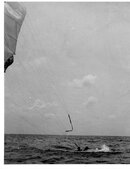We finally completed the last jump, a night water jump which turned into a disaster for me. We jumped into Eglin Bay from a HC-130. It was a very dark night, and I was leery about the jump for some reason. Usually I liked jumping by now, but this was a full scuba jump, with the tanks, the reserve parachute, a medical kit, and a butt-boat (one-man survival raft). Looking out the door, I could see almost nothing as we were not dark-adapted for the jump (the lights in the plane had not been dimmed).
I jumped, felt a good opening, and was relieved to be out of the heat of the plane. The water was less than a minute below me. After checking the ‘chute, my next task was to pull the pins of the risers so I could steer. But something was not right with my right riser group. Rather than going up at an angle, these two risers went straight up. I looked up, and there was a wrap of parachute line from the rear of the skirt down to the risers, which had been looped over the other riser, forming a half hitch around both risers. This kept the two risers together, and made it impossible to use this riser group for steering. We were still using the slip-riser method of steering the canopy by distortion of the rear steering oval in the ‘chute. With only one riser group to steer with, I made a poor, down-wind landing into the water. I hit hard on my fins, then dove face-first into the inky black, salty bay. Coughing and sputtering, I got to the surface just in time for the canopy to start pulling me through the water. Still face-down, I grabbed another breath, and released the left Capwell Quick-release. The risers flung away, and I was at last free on the surface, or so I thought.
While I rested, the current in the bay and the wind carried me into the unseen parachute shroud lines, and they began tangling around my diving tank and regulator. When I was pulled from the water, I had these lines all over my tank and my leg. It took a few minutes to clear up the mess. Then I was asked by one of the instructors, “What would you have done if this was a mission?” The implication was that I would have needed rescuing rather than being the rescuer.
I had a good reply, and pulled out my diving knife with its seven-inch long blade, the orange-handled Sportsways dive knife with the Soligen stainless steel I had gotten from my parents several years prior for my birthday. Unlike the military-issue knives, with Japanese “stainless” steel that rusted and which would not hold an edge (and rarely were sharpened), this knife was razor sharp. I told them that I simply would have cut those lines off me like I did the fishing line that was a perpetual problem for divers in the Pacific Northwest. But in a training situation, I couldn’t do that as it would destroy a valuable parachute. On a mission, the parachute was expendable, and they usually were allowed simply to sink.
I then told them of my problem with the riser, and the half-hitch over the group which precluded my using it for steering. I’m not sure that they believed me, but this allowed me to get through the jump. To this day I don’t know if that was purposely done in packing the chute, or accidentally happened either in the packing or the deployment.
Whatever the cause, this jump cost me the “outstanding student” ranking. That went to another. Without this incident, it would have been mine, but that did not matter and I did not even know I was in that position until after graduation. What mattered was graduating, and I had completed the last requirements of Pararescue Transition School.
Copyright 2016, John C. Ratliff
From my unpublished manuscript, Between Air and Water, the Memoir of an USAF Pararescueman




